Note: Several US staff visited Gaza recently. Aura Kanegis, AFSC's Director of Public Policy and Advocacy, was among them. This was her first trip to Gaza. These are her reflections and photographs from the trip witnessing the recent devastation of Operation Protective Edge, just the latest round of violence against a people under siege. - Lucy
The taxi bounces slowly over rutted roads as we emerge from the no-man’s-land enforced by Israeli machine gun towers, passing Bedouins tending sheep and an emaciated donkey pulling a worn cart. A large apartment building before us has been destroyed, skeletal remains of concrete pilings still leaning precariously in place. Young children are picking through the debris inside, and as parents of small kids the three of us take in a collective breath, terrified by the risk to their lives. But this crumbling structure is only one in a lifetime of unacceptable risks they face for being born Palestinian in Gaza.
We are quiet for much of the drive to our office. Gaza City looks like many I've seen throughout the world – pockets of grinding poverty interspersed with garish commerce, tall buildings and bright signs, traffic and fumes mixed with livestock. We arrive at a building with the AFSC star among its lobby signs and ride a small elevator to the fifth floor. Our colleagues gather to greet us, and we ask impossible questions: How are you? How is your family?
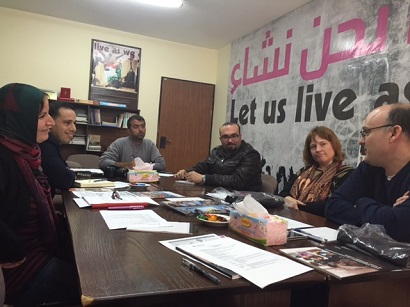
They and their families weathered 51 days of war this summer, the third time in six years Israel has undertaken major military action in Gaza. By all accounts this was the worst, with nearly 2,200 killed, three-quarters of these civilians. We mention the destroyed building we saw on our way in. “A building??” one of our friends exclaims, and in a few hours it is clear why she reacted with surprise at our singular focus.
We are taken on a tour through the surrounding areas. Our colleague begins to point out empty spaces in the city blocks, sudden, square vacancies like missing teeth. “This was the home of …. Up here was ….” We ask at each house what happened, did everyone - or anyone - survive. These houses, they explain, were hit by F-16s. Entire families “surgically” removed.
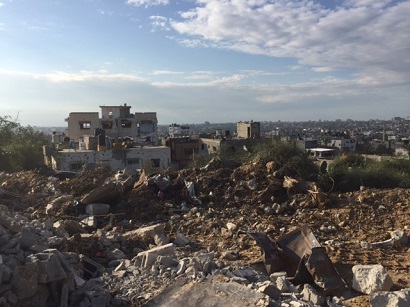
And then we are in Shuja’iyya. The evidence of deadly surgery spreads wide to full-scale blocks of destruction, massive piles of rubble, more concrete and rebar skeletons broken and dangling, devastation as far as the eye can see. We stop asking about survivors, but we see them persisting with life amid the wreckage – entire families living in precariously balanced upper floors of smashed and tilted buildings, laundry hung across ruins, kids playing a makeshift game of volleyball strung across a narrow street between crumbled houses.
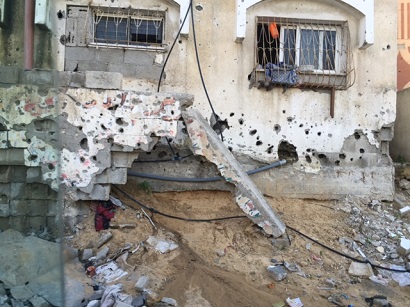
Those houses still standing are riddled with massive bullet and mortar holes. A cemetery wall has been blown apart, gravestones smashed in a grim second death. Clothes, lamps, dolls, and signs of everyday life have been churned into rubble by the manmade tornado that destroyed block after city block. Kids swarm through the street in school uniforms, while many adults simply sit inside their destroyed homes, waiting. Amid the chaos we see a group gathering, then music… it is a wedding. Here and now, a wedding.
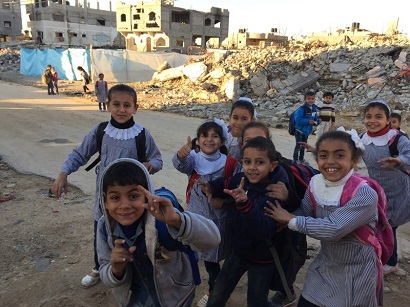
The colleague guiding us is from this area. During the war he fled with his pregnant wife and three kids to stay with family in Gaza City, but the morning after Shuja’iyya was targeted he came back to check on their home and neighbors. “It smelled of death everywhere,” he says evenly. Back at his uncle’s house their story was like many others: 30 people living in a small space meant for one family, living shoulder to shoulder and taking turns sleeping in shifts for weeks on end. Only the babies got to sleep when they wished. We hear from others about their experience of the alleged warning system Israel used during its operation, striking at night with a first “knock” from a small missile announcing you had at best three minutes to evacuate your family before a much larger missile came to liquefy your house – I think of how long it would take to get my sleeping children out of the house and shudder.
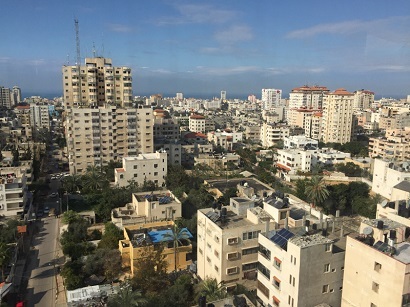
While we look down from the highest point in Gaza on the site of a destroyed water tank that had served the entire area, the call to prayer echoes across the sprawling city below – we can hear dozens of muezzin each calling out the Adhan at their own pace and cadence in a haunting, discordant chorus. From atop this hill it is clear that the idea of Hamas using the population as “human shields” is a red herring – there is not a square inch of unpopulated space. Gaza is all humanity.
This strip of coast is one of the most densely populated places on earth, with over 1.6 million occupants trapped in a 365 kilometer square area often called an open-air prison – they cannot leave, their economy has been brought to a standstill by many years of Israeli-enforced siege, and they experience collective punishment in nearly every dimension of their lives.
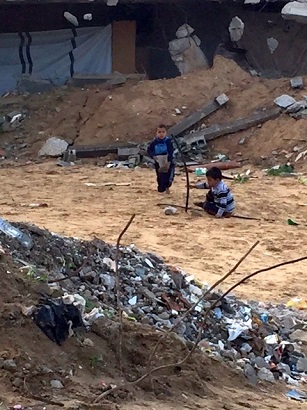
Is it any wonder that people living under these conditions chose a political party like Hamas that promised action and resistance, or that ever more radical groups now offering an outlet for a violated people’s rage are gaining support? Is it surprising that they shoot makeshift rockets, dig tunnels to circumvent the siege, dream of overthrowing their captors? What do Israel and the U.S. think they will buy by crushing this population again and again until every ounce of hope has been drained?
Amid so much trauma and anger, we three Americans are treated with kindness everywhere we go. Gazans seem to understand the difference between the actions of a government and the humanity of a people.
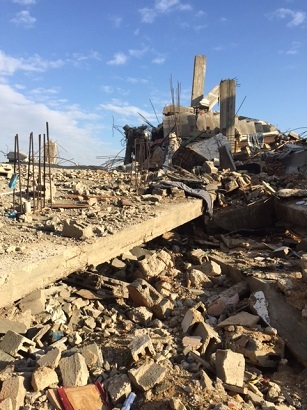
We move on through Beit Hanoun, our eyes beginning to normalize the devastation after hours of witness. I see only one bulldozer during our tour – OCHA’s Access Coordination Unit reports that Israeli authorities have allowed just 2.9 percent of the materials needed for reconstruction and recovery to enter Gaza, with fewer reconstruction materials arriving in November than during the previous three months. Just 287 trucks of construction materials were allowed to enter Gaza last month; to complete reconstruction within three years, a minimum of 735 truckloads of construction materials is needed per day. Gaza had already been in desperate need of construction materials before this devastation; at the current pace it will take at least 20 years just to rebuild the Gaza Strip to what it was before this summer’s military operation.
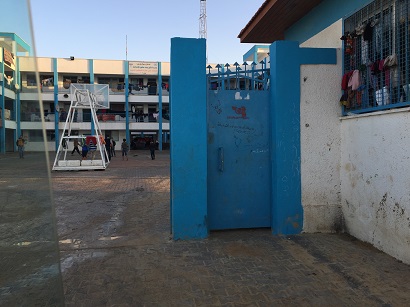
We stop briefly at a UN Relief and Works Agency (UNRWA) school that has been taken over by hundreds of the 100,000 people still homeless since the latest military operation in Gaza. We find no UNRWA staff or services – the building has been abandoned to the refugees. Their desperation is deep and obvious, months spent piled into tiny spaces, starving and struggling to carry on without knowing what if any relief might come. I want to hand over my belongings, give something, anything into the yawning void of need here – but the only true relief possible from this unnatural disaster is an end to the siege and occupation.
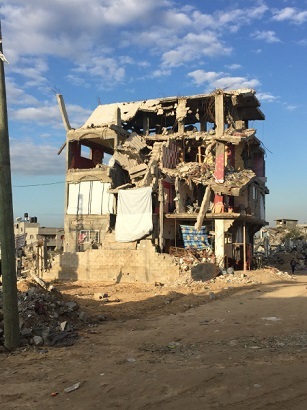
That night we meet over dinner with local AFSC steering committee members and community leaders, an extraordinary group of women and men – heads of clinics, human rights organizations, well known doctors and professors, deep thinkers. They remind us of AFSC’s long history in Gaza, where we first came to assist with refugees in 1949. We handed that early work over to UNRWA on principle – it was our view that the refugees should be repatriated, not kept in limbo any longer – but unfortunately their right of return is no closer to being realized now, 65 years later. 1.1 million Palestinian refugees remain in Gaza, forbidden from returning to their former villages in Israel.
We talk with the gathered leaders about our current program work and relief efforts. We discuss geopolitics and what the future might hold for the broader Middle East. We learn later of the crushing losses each of these extraordinary people suffered over the summer -- one woman lost 11 family members, another both his parents, and another’s home was destroyed. We are dumbfounded that they could maintain any semblance of sanity, let alone speak with a modicum of detachment about the situation. “But this is Gaza,” our colleague reminds us with a shrug.
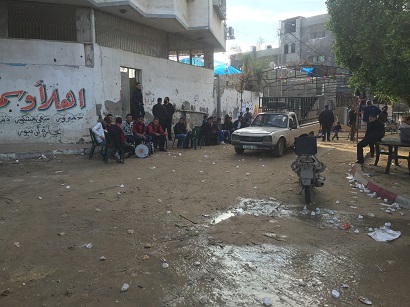
My family on my dad’s side are Lithuanian Jews. They too knew desperation and death at the hands of people who had decided their very existence was a threat. When we return through the Kafka-esque Israeli border control at Erez crossing, I am wrenched again by the same complicated set of feelings I navigated six years ago on my first trip to Israel/Palestine – angry and alien in what cannot rightly be called anything but apartheid Israel, and at the same time seeing ghosts of myself and members of my family in the faces and mannerisms of so many Israelis.
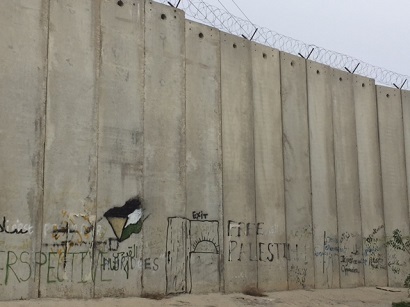
Crimes against humanity have been committed in all of occupied Palestine in a deeply misguided quest for security by those once targeted for the same. Beyond the more obvious violence in Gaza we see slow and systematic ethnic cleansing in the West Bank and East Jerusalem through continuing displacement from sprawling illegal settlements, land grabs, the separation barrier, a network of settler roads Palestinians cannot use, resource theft, carefully constructed economic isolation, crushing restrictions of Palestinian movement, and a network of racist laws.
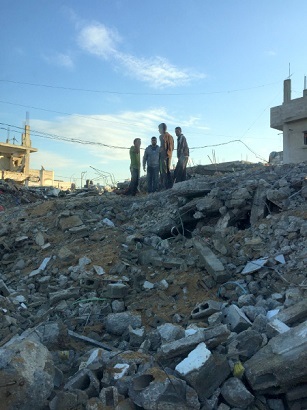
But there is no “them” to blame – in us are the seeds of this violence, this inhumanity, perpetuated by both our directed policies and our overwhelming apathy. We bought the weapons fired on families in Gaza – now touted as “battle tested” in slick corporate marketing – with our tax dollars. We too are inclined to recognize and fear “violent extremism” most when it is used against people who look like us. We too have built our wellbeing on the spoils of someone else’s Nakba.
How many more shameful chapters in our species’ story will be fueled by the intoxicating cocktail of nationalism, fear, profit, militarism, racism? The devastation we’ve seen today has so many cousins of different scales and profiles, variations on a theme from Bir Nabala to Ferguson, Mogadishu, Pine Ridge, Mosul. There is so much work to do.